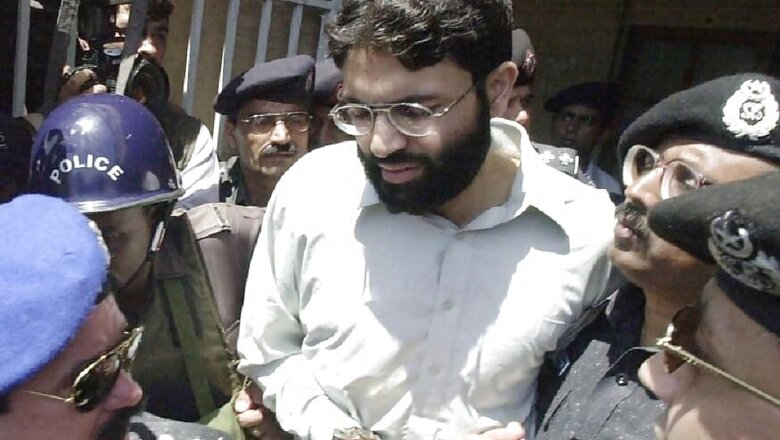
views
New Delhi: Testimony presented in legal proceedings in Pakistan shows key suspects in the murder of journalist Daniel Pearl met with each other at the offices of terror outfit Jaish-e-Muhammad in Karachi’s Falal Masjid, court documents have revealed.
The testimony casts new light on the links of the terrorist group and its patrons in Pakistan’s Inter-Services Intelligence (ISI) — including now-federal minister Brigadier Ijaz Shah — with the journalist’s 2002 killing.
Former Harkat-ul-Mujahideen member Salman Saqib, the documents show, told a magistrate that he met with Ahmed Saeed Omar Sheikh, who is alleged to have played a key role in Pearl’s killing, at the Jaish-e-Muhammad’s office in December 2001.
The two men, Saqib said in a confessional statement, had earlier met in a procession held in January 2000.
Both Saqib and Sheikh were ordered free by the Sindh High Court last week, along with two others after the two-judge bench of Justices Kareem Khan Agha and Muhammad Saleem Jessar held that confessional statements key to the prosecution may have been coerced. The men, however, have since been detained pending an appeal by the government.
The January 2000 procession, a former Pakistan police officer familiar with the case has told Network18, was held to celebrate the return of Jaish-e-Muhammad chief Masood Azhar Alvi, who had been released, along with Sheikh, from jail in India in return for hostages held on an Indian Airlines jet hijacked to Kandahar in December 1999.
“I have come here because this is my duty to tell you that Muslims should not rest in peace until we have destroyed America and India,” Azhar said at the procession, as a crowd of over 10,000 people cheered.
Later, the police officer said Azhar was admitted for gall-bladder surgery at the Burq Poly-Clinic hospital in Bahawalpur. Sheikh, he said, stayed with the jihad commander for several days in the first two weeks of 2002—just as the Pearl murder plot was being conceived — tending to him along with family members.
But, the court documents show, police chose not to record evidence on who introduced the two men — and, critically, why Saqib chose to participate in a murder plot, simply on the basis of a cursory introduction.
“There’s no doubt Saqib knew Sheikh was someone close to Azhar, and with good connections to the ISI,” the officer said. “There’s no other reason why he would have agreed to participate in a high-risk terrorist operation, simply on the basis of two cursory meetings”.
Born in Multan in 1975, and the graduate of a physics college in Bahawalpur—the city where the headquarters of the Jaish-e-Muhammad is now located — Saqib served with Harkat-ul-Mujahideen insurgents fighting alongside the Afghan Taliban until he was seriously injured in 1999.
For many experts and officials familiar with the case, the answer to why the Jaish-e-Muhammad’s links with the Pearl murder were overlooked or ignored by police investigators centres around one man: Brigadier Ijaz Shah, from 1999 to 2002 as ISI officer directly responsible for jihadist groups in Pakistan’s Punjab, and now the country’s interior minister.
Brigadier Shah, many familiar with the case believe, sought to suppress embarrassing revelations emerging from the case on the links between anti-India jihadists backed by the ISI, and Pakistan’s intelligence services.
In 2003, evidence surfaced before the Central Intelligence Agency that Pearl had been physically executed by top al-Qaeda operative and 9/11 organiser Khalid Sheikh Mohammad. But Sheikh, court records show, was never questioned on how the kidnappers came into contact with the top al-Qaeda leadership, and why the decision was made to involve them in the journalist’s murder.
Brigadier Shah is known to have used his connections to persuade Sheikh to surrender to the ISI on February 6, 2002—after which he, mysteriously, spent over a week in the covert service’s custody, unknown to both the police and the United States’ embassy in Islamabad.
The Sindh High Court rejected evidence ostensibly recovered from Sheikh on February 13, when he was arrested by police, noting that his illegal incarceration made it possible the material had been planted by investigators — but did not comment on Brigadier Shah’s role, or what transpired from February 6-12.
But time spent by Sheikh in Brigadier Shah’s custody, some accounts suggest, was spent instructing him not to disclose information on the kidnappers’ links to anti-India jihadist groups, as well as their ties to al-Qaeda and Pakistan’s intelligence services.
Lashkar-e-Jhangvi Karachi chief, Ata-ur-Rehman, who was among those police records state was responsible for holding Pearl prisoner, told authorities Pearl was still alive on February 6 — raising disturbing questions about the reasons for the journalists’ execution in the midst of what many believed were promising negotiations for his release.
For reasons that have never been made public, several jihadists known to have participated in the operation — among them, Kandahar hijack plot planner Amjad Farooqi, his deputy Asim Ghafoor, murder witness Fazal Karim — were never brought to trial, though some were held in custody for months.
Intelligence services and experts have known that the Jaish, and its sources of patronage in the ISI, lay at the centre of a complex universe of jihadist groups — among them, the Afghan Taliban, the Harkat-ul-Mujahideen, Harkat-ul-Jihad-e-Islami, and transnational organisations like al-Qaeda. Nizamuddin Shamzai, a prominent Karachi-based cleric assassinated in 1994, served as mentor to leaders of these various groups.
Following Masood Azhar’s arrest, in February 1994, during a mission to unite feuding jihadists in Kashmir, multiple efforts were made to secure his release. First, the Harkat-ul-Ansar kidnapped several Western tourists in Kashmir. Then, in September-October, 1994, Sheikh kidnapped three British and one American hostage in a bid to force India to release him.
Nasser al-Bahri, the long-time bodyguard to Osama Bin Laden, later claimed the al-Qaeda chief “ordered al Qaeda to plan the Indian airlines hijacking with Harkat”. “Bin Laden admired Azhar and needed his help”, al-Bahri claimed. “Bin Laden threw a lavish party for Azhar when he was freed in Kandahar”.




















Comments
0 comment